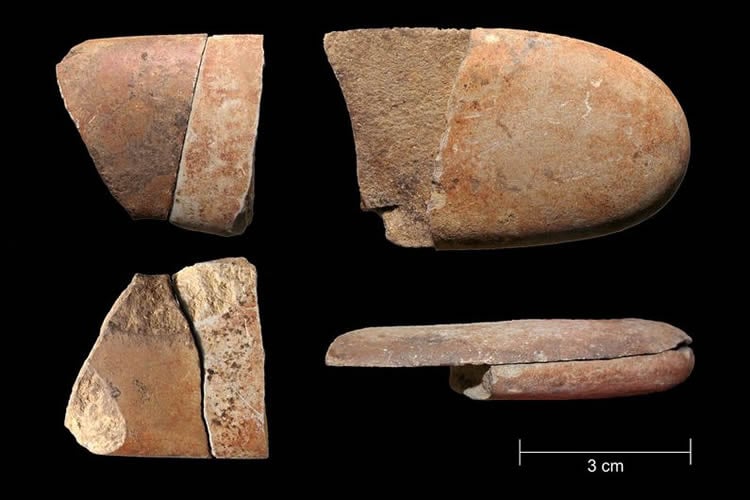Summary: Researchers report humans may have destroyed objects to remove their symbolic power up to 5,000 years earlier than previously thought.
Source: University of Montreal.
Researchers from Canada, the U.S. and Italy uncover evidence that people in the Upper Paleolithic Period used stone spatulas to decorate the bodies of the dead with ochre..
Humans may have ritualistically “killed” objects to remove their symbolic power, some 5,000 years earlier than previously thought, a new international study of marine pebble tools from an Upper Paleolithic burial site in Italy suggests.
Researchers at Université de Montréal, Arizona State University and University of Genoa examined 29 pebble fragments recovered in the Caverna delle Arene Candide on the Mediterranean Sea in Liguria. In their study, published online Jan. 18 in the Cambridge Archeological Journal, they concluded that some 12,000 years ago the flat, oblong pebbles were brought up from the beach, used as spatulas to apply ochre paste to decorate the dead, then broken and discarded.
The intent could have been to “kill” the tools, thereby “discharging them of their symbolic power” as objects that had come into contact with the deceased, said the study’s co-author Julien Riel-Salvatore, an associate professor of anthropology at UdeM who directed the excavations at the site that yielded the pebbles.
The Arene Candide is a hockey-rink-sized cave containing a necropolis of some 20 adults and children. It is located about 90 metres above the sea in a steep cliff overlooking a limestone quarry. First excavated extensively in the 1940s, the cave is considered a reference site for the Neolithic and Paleolithic periods in the western Mediterranean. Until now, however, no one had looked at the broken pebbles.
Next oldest evidence dates to the Neolithic
“If our interpretation is correct, we’ve pushed back the earliest evidence of intentional fragmentation of objects in a ritual context by up to 5,000 years,” said the study’s lead author Claudine Gravel-Miguel, a PhD candidate at Arizona State’s School of Human Evolution and Social Change, in Tempe. “The next oldest evidence dates to the Neolithic period in Central Europe, about 8,000 years ago. Ours date to somewhere between 11,000 and 13,000 years ago, when people in Liguria were still hunter-gatherers.”
No matching pieces to the broken pebbles were found, prompting the researchers to hypothesize that the missing halves were kept as talismans or souvenirs. “They might have signified a link to the deceased, in the same way that people today might share pieces of a friendship trinket, or place an object in the grave of a loved one,” Riel-Salvatore said. “It’s the same kind of emotional connection.”

Between 2008 and 2013, the researchers painstakingly excavated in the Arene Candide cave immediately east of the original excavation using small trowels and dental tools, then carried out microscopic analysis of the pebbles they found there. They also scoured nearby beaches in search of similar-looking pebbles, and broke them to see if they compared to the others, trying to determine whether they had been deliberately broken.
Implications for research at other sites
“This demonstrates the underappreciated interpretive potential of broken pieces,” the new study concludes. “Research programs on Paleolithic interments should not limit themselves to the burials themselves, but also explicitly target material recovered from nearby deposits, since, as we have shown here, artifacts as simple as broken rocks can sometimes help us uncover new practices in prehistoric funerary canons.”
The findings could have implications for research at other Paleolithic sites where ochre-painted pebbles have been found, such as the Azilian sites in the Pyrenee mountains of northern Spain and southern France. Broken pebbles recovered during excavations often go unexamined, so it might be worth going back and taking a second look, said Riel-Salvatore.
“Historically, archeologists haven’t really looked at these objects – if they see them at a site, they usually go ‘Oh, there’s an ordinary pebble,’ and then discard it with the rest of the sediment,” he said. “We need to start paying attention to these things that are often just labeled as rocks. Something that looks like it might be natural might actually have important artifactual meaning.”
Funding: Funding of the data collection was provided by the Italian Ministry of Cultural Goods and Tourism of the region of Liguria, with support from the city of Finale Ligure and the Società Cave Arene Candide S.r.l. Funding for the excavations at the site was provided by Fredy S.p.A and the University of Colorado, Denver. The analysis presented in this study was funded by the Social Science and Humanities Research Council (Fellowship no. 752-2011-1115-A14) and the School of Human Evolution and Change, at Arizona State University.
Source: Jeff Heinrich – University of Montreal
Image Source: NeuroscienceNews.com image is credited to the researchers.
Original Research: Abstract for “The Breaking of Ochred Pebble Tools as Part of Funerary Ritual in the Arene Candide Epigravettian Cemetery” by Claudine Gravel-Miguel, Julien Riel-Salvatore, Roberto Maggi, Gabriele Martino and C. Michael Barton in Cambridge Archaeological Journal. Published online January 18 2017 doi:11.1117/S0959774316000640
[cbtabs][cbtab title=”MLA”]University of Montreal “Broken Pebbles Offer Clues to Paleolithic Funeral Rituals.” NeuroscienceNews. NeuroscienceNews, 11 February 2017.
<https://neurosciencenews.com/paleolithic-funeral-rituals-evolution-6099/>.[/cbtab][cbtab title=”APA”]University of Montreal (2017, February 11). Broken Pebbles Offer Clues to Paleolithic Funeral Rituals. NeuroscienceNew. Retrieved February 11, 2017 from https://neurosciencenews.com/paleolithic-funeral-rituals-evolution-6099/[/cbtab][cbtab title=”Chicago”]University of Montreal “Broken Pebbles Offer Clues to Paleolithic Funeral Rituals.” https://neurosciencenews.com/paleolithic-funeral-rituals-evolution-6099/ (accessed February 11, 2017).[/cbtab][/cbtabs]
Abstract
The Breaking of Ochred Pebble Tools as Part of Funerary Ritual in the Arene Candide Epigravettian Cemetery
We present the analysis of 29 human-transported limestone pebbles found during recent excavations (2009–11) in the Final Epigravettian levels at the Caverna delle Arene Candide, Italy. All pebbles are oblong, most bear traces of red ochre and many appear intentionally broken. Macroscopic analyses demonstrate morphological similarity with pebbles used as grave goods in the Final Epigravettian necropolis excavated at the site in the 1940s. Mediterranean beaches are the most plausible source for the pebbles, which were carefully selected for their specific shape. Microscopic observation of the pebbles’ surfaces shows traces of ochre located on the edges and/or centres of most pebbles. A breakage experiment suggests that many pebbles were broken with intentional, direct blows to their centre. We propose that these pebbles were used to apply ochre ritually to the individuals buried at the site, and that some were subsequently ritually ‘killed’. This study emphasizes the importance of studying artefacts that are often ignored due to their similarities to simple broken rocks. It also provides a method to study pebbles as a distinct artefact category, and shows that even broken parts should be studied to understand the story told by such objects in the context of prehistoric human social systems.
“The Breaking of Ochred Pebble Tools as Part of Funerary Ritual in the Arene Candide Epigravettian Cemetery” by Claudine Gravel-Miguel, Julien Riel-Salvatore, Roberto Maggi, Gabriele Martino and C. Michael Barton in Cambridge Archaeological Journal. Published online January 18 2017 doi:11.1117/S0959774316000640






